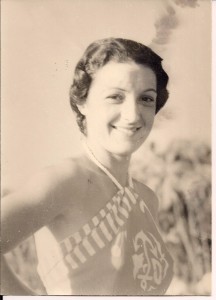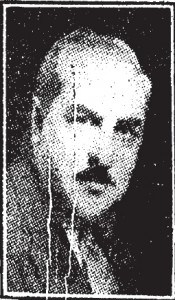Last month, I wrote a note on this site about Mena Silas, the now-forgotten Baghdadi Jewish composer who wrote Taj Mahal, the foxtrot after which my book is named. A couple of days ago, a woman named Patricia Kaden who lives in Cremona, Italy, was sorting through the papers of her mother, Georgia, and came upon a small note indicating that Mena Silas had written a tune for her titled Waltz for Georgette. Patricia did an internet search for Silas and found me.
We’ll probably never know what Waltz for Georgette sounds like (Patricia couldn’t find the score), but the woman in whose honour the tune was written lived a most interesting life in India. Her father – Patricia Kaden’s grandfather – was named Gaston Quiribet. Though he was French, he had worked for the famous Shepperton Studios in England and made animated films on the side, which he referred to as “Q-riosities”. He was also an expert in trick photography. In the 1930s, he arrived in Bombay after being hired by Kodak-Eastman to make films about India and Burma. He set out for the subcontinent with his family.
Years later, Georgette told her story to someone making notes about senior citizens and she remembered being surrounded by an army of servants, who sometimes put Eno’s fruit salts into the soup instead of ordinary salt, resulting in rather bubbly mealtimes. Among the incidents that stood out was a trip to Mysore, where her father was working on the film Sabu.

The team lived on the Maharaja’s estate for two-and-half months as they shot the film, and the ruler lent them his most docile elephant: a lumbering beast named Kalanagh. Georgette recalled that the animal would be slathered with layers of makeup every morning to hide its blemishes. But as the sun rose higher, Kalanagh would pick up dust with its trunk to spray on its back to protect it against the heat, undoubtedly driving the film crew crazy.
In one scene, the elephant was supposed to steal a melon drying on the roof of a bamboo hut. But since it was early in the season, the fruit were not ripe and Kalangh kept spitting them out. In the end, the director decided to have him eat bananas instead. In another scene, the elephant was supposed to nearly crush a baby who had accidentally crawled into the street. But though his keepers tried to coax him to action, Kalanagh refused to put his foot on the child-actor. In the end, the filmmakers had to use a cloth bundle. When the film was developed, it showed that the elephant had put all his weight on his other feet, ensuring that there was no possibility of harming the child substitute. Later, Georgette remembered being taken to the Dussera celebrations at the Maharaja’s place and being fed ice cream topped with real gold leaf.
Back in the city, her father became the president of the Alliance Francaise and also headed the French National Committee of Bombay during World War II, urging his compatriots in India to return to Europe to join De Gaulle’s army. He also made broadcasts on AIR about the situation on the Continent. Georgette – or Georgia as she was known to her family – returned to France after the war. She passed away in 1999.




4 comments
The film being made was Elephant boy, dir. Robert Flaherty and Zoltan Korda, 1937. Robert Flaherty, the famed documentary maker of Nanook of the North (1922) and Man of Aran (1934), shot extensive wildlife footage in India. Korda, worried about marketing, decided to graft on the story of Kipling’s ‘Toomai of the elephants’. Though the magnificent tusker, Irawat, who plays Kala Nag, was much admired, he did not play a character as such but was the companion of the orphaned boy, and whose management brought the boy status and respect in British and Indian society. The film established the first international Indian superstar, Sabu, a mahout’s son from Mysore and the film was successful commercially and acclaimed critically; it won awards at Venice Film Festival the same year as the Marathi devotional film, Sant Tukaram, dir. VS Damle and S Fattelal, creating an image of a religious, pre-British India of a gentle masculinity of a saint, very different from that of Korda’s hyper-masculine film which has no female characters.
Hi Naresh,
Congratulations!!
I was listening to your interview today (10th Jan 2012) on NPR, US.
It was very interesting to know the history of our own Indian Jazz; you did a great work of bringing out this hidden gem. The overall interview was very informative and touchy.
Are the old compilations available commercially ?
Would keep visiting your site.
God bless you!!
Thx
Harshad Markandeywar
Harshad,
Alas, there aren’t any CDs yet, except for the one that is included in my book. But do check out the audio guide section of this site for more music.
Hi Naresh,
I have an original 6 page score by Mena D. Silas,wonder if this is the same composer. It’s called Valse Mona, my grandmother. Mona Gill Molloy.
The front of the score says dedicated to Miss Mona Molloy. Unsure of date, but she was born
in 1893 in Shanghai and was of Manx origins. My father was born in Shanghai in 1919 so if
the score reads right, it was before 1919. My grandparents came to Victoria BC in 1927.
Only my grandmother and mother were able to get through score, it’s too difficult for me!
You can tell it’s original by the ink blots! Any suggestions on joining this up with his compositions?
Peter